Sparkling Water Concept Test
Liquid Death vs. Spindrift
Executive Summary
This concept test aimed to understand consumer perceptions of two sparkling water brands, Liquid Death and Spindrift, identifying key drivers of purchase interest and rejection, and uncovering potential consumer segments and occasions. The study involved 101 consumers.
What We Learned
Liquid Death
- High Uniqueness, Extreme Polarization: Liquid Death stands out with a very high Uniqueness score (65.3% Top 2 Box). Its edgy, dark branding featuring skulls and phrases like "Murder Your Thirst" is highly polarizing.
- Appeals to a Niche: Younger consumers found the branding unique, intriguing, "cool premium," and aesthetically pleasing, evoking excitement and a sense of rebellious style.
- Major Brand Clarity Issues: A significant proportion of consumers were confused, mistaking Liquid Death for an alcoholic beverage or energy drink.
Spindrift
- Clear Health & Natural Appeal, Lower Uniqueness: Spindrift's primary appeal lies in its "real squeezed fruit" and "unsweetened" claims, which resonated strongly with health-conscious consumers.
- Minor Identity Confusion: While less polarizing than Liquid Death, some consumers perceived Spindrift as a "kid's drink" due to its simplicity.
Objectives
- 1Understand perception differences between Liquid Death and Spindrift.
- 2Identify key drivers of purchase interest and rejection for each concept.
- 3Uncover potential consumer segments and occasions for each product.
Approach
This study utilized a quantitative and qualitative concept testing approach with a total of 101 consumers. Quantitative measures included Top 2 Box and Bottom 2 Box Purchase Intent, as well as Uniqueness scores for each brand. These metrics were supplemented by qualitative feedback captured through open-ended questions and discussions.
Respondent Profile & Consumption Habits
Sparkling Water Consumption Frequency
The survey captured a diverse audience with varied sparkling water consumption habits...

Demographic Snapshot
The respondent base is entirely from the United States...
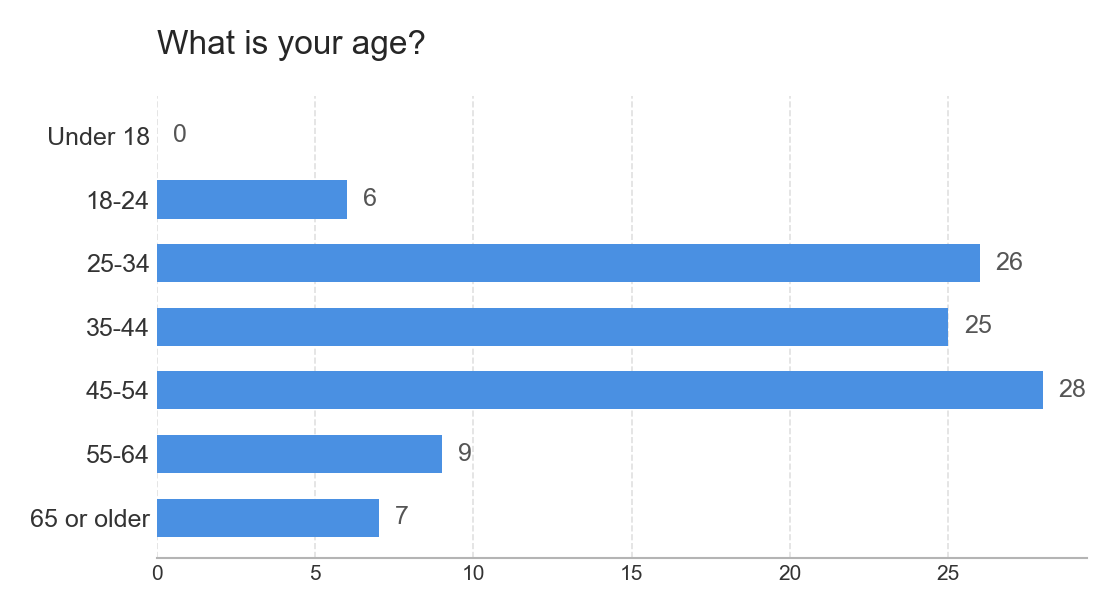
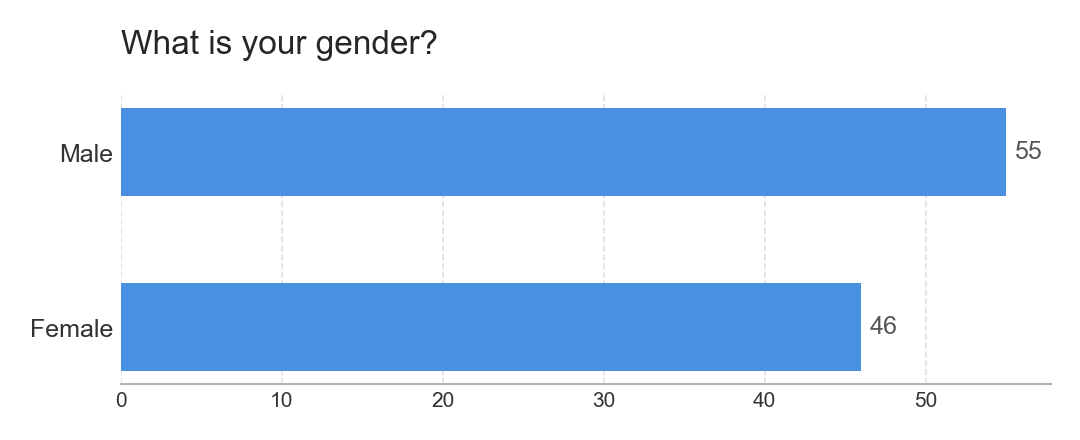
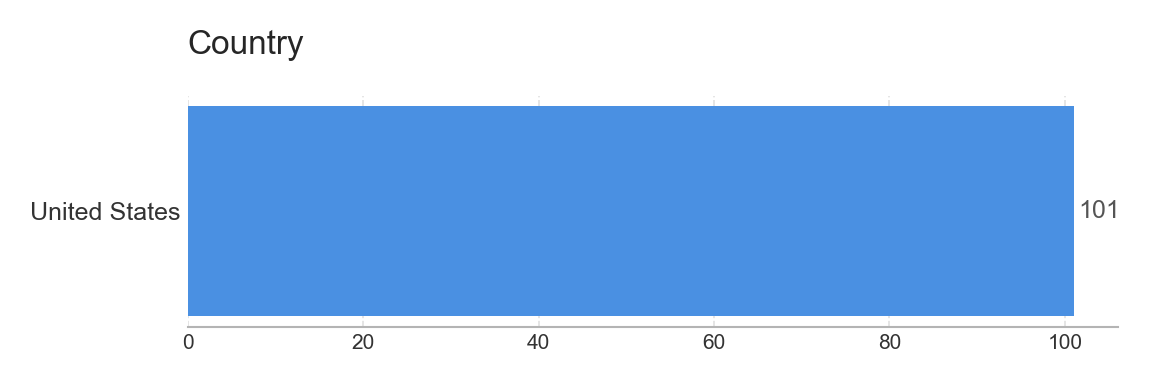
Head-to-Head Concept Comparison
When placed in direct comparison, Spindrift demonstrates significantly higher purchase intent...
Purchase Intent
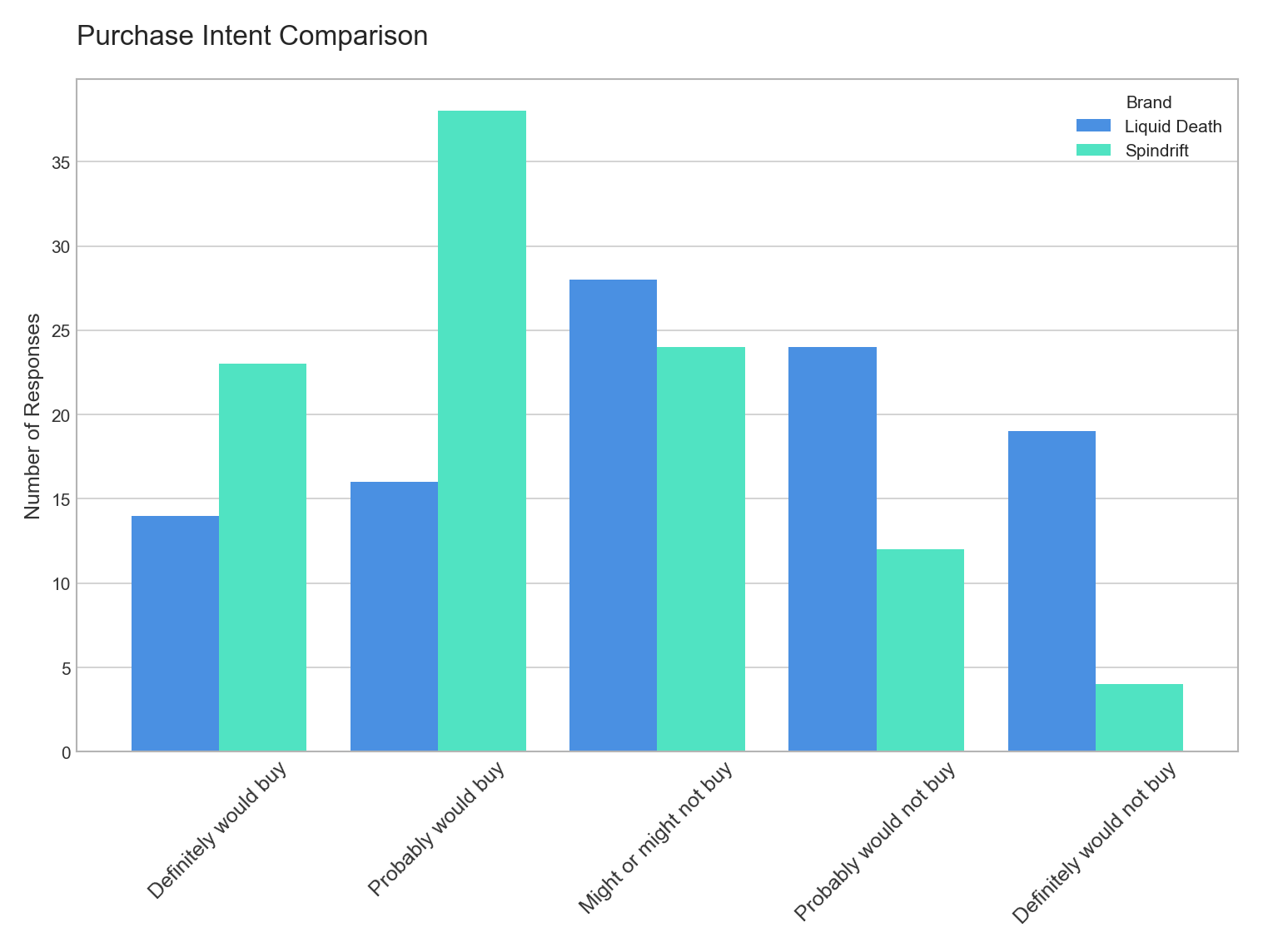
Perceived Uniqueness
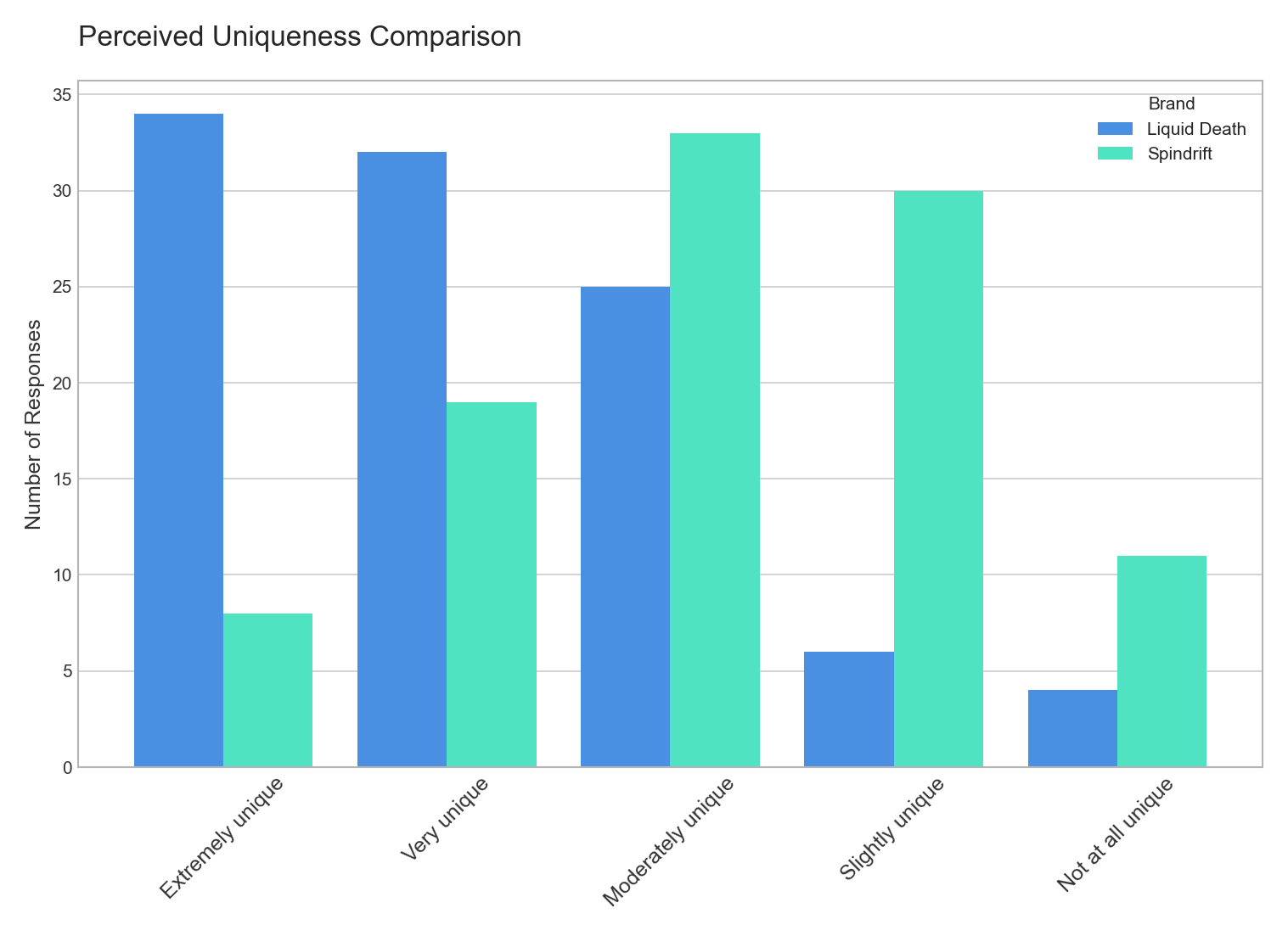
Deep Dive Analysis: Liquid Death
Initial Impressions & Brand Perception
Analytical Summary of Initial Impressions: Liquid Death Sparkling Water
This analysis synthesizes initial thoughts from ten open-ended responses regarding Liquid Death sparkling water. The brand elicits strong, often polarizing, reactions, primarily driven by its highly distinctive branding and packaging strategy.
Dominant Themes:
- 1Striking, Edgy, and Attention-Grabbing Aesthetics: Nearly all respondents immediately recognized Liquid Death as unique and attention-grabbing. Terms like "eye-catching," "edgy," "unique design," "stands out," and "different" were common. The brand's visual identity is overwhelmingly successful in disrupting conventional sparkling water packaging.
- 2Ambiguity in Product Category Perception: A significant theme is the brand's ability to blur lines between product categories. While it is sparkling water, many respondents initially mistook it for a "soft drink," "energy drink," or, most notably, an "alcoholic beverage" (beer or malt liquor) due to the can's size, design, fonts, and overall dark/sinister aesthetic.
- 3Polarizing Appeal: The brand's "over-the-top" and "hostile" imagery is a double-edged sword. While some respondents are drawn to its unique and "sinister" aesthetic, others find it "too intense," "not friendly," and even off-putting, especially for certain demographics (e.g., children).
Key Aspects of Branding and Packaging that Stand Out:
- Can Format & Size: The 19-ounce can is noted as "unique" and "distinctive" for sparkling water, often contributing to the perception of it being a soft drink or alcoholic beverage. The preference for cans over plastic bottles due to sustainability was also mentioned positively.
- Logo and Imagery (The Skull): The melting skull imagery is a central, impactful element. It consistently registers as "intense," "sinister," and contributes significantly to the "edgy" vibe. For one respondent, it strongly triggered memories of past alcohol consumption.
- Name ("Liquid Death") and Tagline ("Murder Your Thirst"): These elements are universally recognized as "unique," "powerful," "sinister," and "intriguing." They amplify the brand's aggressive and non-traditional persona, resonating with those who appreciate the aesthetic.
- Color Palette and Tone: The "blacked out," "muted," and "darker side" appearance stands in stark contrast to the typically "fun and colorful" packaging of other sparkling water brands, making it "different" and easily identifiable on a shelf.
- Target Audience Perception: Respondents believe the brand is designed to appeal to "younger individuals," "men," "alternative people," and those who "don't normally drink sparkling water," positioning it as an alternative to more "feminine" or benign sparkling water options.
Positive Reactions:
- High Attention Value: The brand is extremely effective at grabbing attention and being memorable.
- Uniqueness and Differentiation: Many appreciate its departure from traditional sparkling water marketing, finding it "different from what I'm used to seeing."
- Aesthetic Appreciation: A segment of respondents genuinely "like the aesthetic," "the whole concept," and find the design "beautiful" or "cool."
- Perceived Taste/Experience: Those who have consumed Liquid Death describe the taste positively, noting "more flavor and energy," "very good," and effective hydration.
- Sustainability: The use of cans is seen as a more sustainable option than plastic bottles.
- Purchase Inclination: For some, the distinctive appearance and edgy appeal make them "more inclined to purchase."
Negative and Mixed Reactions:
- Confusing / "Edgy for Edginess' Sake": Some respondents don't "get it" or feel the edginess is gratuitous, even if it's eye-catching.
- Misleading or Off-Putting Association with Alcohol: The strong resemblance to beer/malt liquor can be problematic, particularly for individuals with a history of alcohol abuse, triggering uncomfortable memories.
- Perceived as "Too Intense" or "Hostile": The imagery and naming convey a sense of aggression that some find unappealing, especially those looking for a "refreshing" or "friendly" beverage. Concerns were also raised about its suitability for children.
- Lack of Traditional "Refreshing Vibe": The brand's intense aesthetic does not align with the "effervescent, refreshing vibe" typically associated with sparkling water.
- Potential Misinformation: Some respondents wondered if it contained caffeine or other non-benign ingredients, indicating a lack of clarity about the actual product beneath the intense branding.
- Lack of Personal Purchase Intent: Some acknowledged its attention-grabbing power but stated it wouldn't make them personally want to buy it.
Conclusion:
Liquid Death sparkling water masterfully leverages provocative branding and packaging to create an undeniably memorable and distinctive product. Its "edgy" aesthetic, spearheaded by the skull imagery, unique name, and dark color palette, successfully differentiates it from the competitive landscape and resonates strongly with a specific alternative demographic.
However, this bold approach also presents challenges: it can create ambiguity around the product category, trigger negative associations (especially with alcohol), and alienate consumers seeking a more traditional, "friendly," or "refreshing" sparkling water experience. Despite these potential pitfalls, the brand's high recognition and the positive feedback from those who have tried it suggest a successful strategy in carving out a unique and profitable niche in the beverage market.
Consumption Occasions
Consumers primarily envision Liquid Death for occasional or situational consumption, rather than as an everyday staple for daily hydration. Many are inclined to try it impulsively out of curiosity or if conveniently available, with social gatherings and parties representing a notable specific use case.
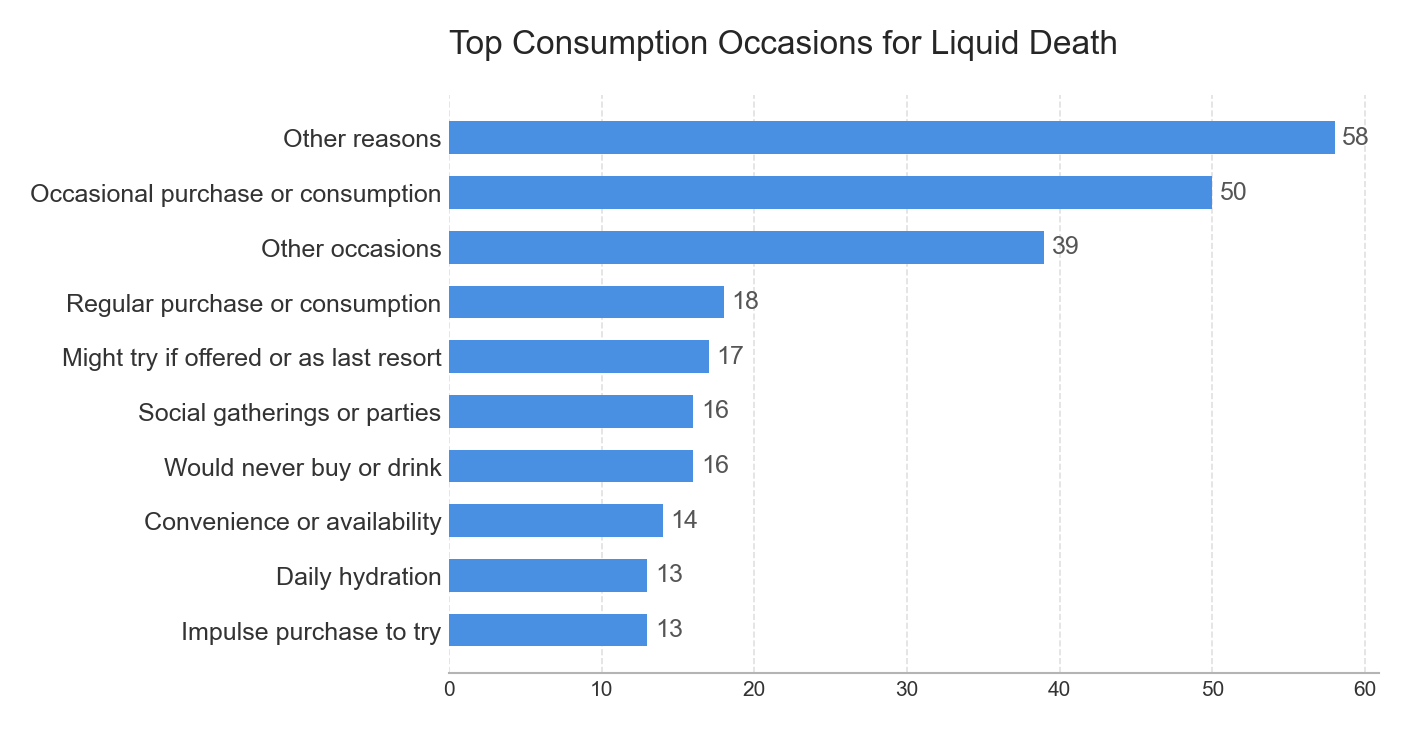
The Liquid Death Drinker Persona
Liquid Death Drinker Persona: The "Edgy, Health-Conscious Challenger"
Based on the sample responses, the typical Liquid Death sparkling water consumer is perceived as an individual who balances a desire for personal wellness with a strong need for unique self-expression and anti-establishment branding.
Perceived Demographics:
- Age: Primarily young, ranging from late adolescents to early twenties (approx. 15-25 years old). Terms like "younger males," "late adolescents," and "early twenties" were frequently used. There's a clear sense that the brand "ages out" after about 25.
- Gender: Leans heavily towards males, with specific mentions of "younger males" being attracted to the design.
- Niche: While primarily young, some respondents also vaguely mentioned "older people" potentially drinking it for perceived energy, though this is a less dominant and likely misinformed perception.
Lifestyle:
- Active & Social: This individual is often engaged in active pursuits such as working out or sports, implying a need for hydration and potentially an "energy boost" (even if misattributed). They may also be social and consume alcohol, seeking rehydration.
- Subcultural Alignment: They are associated with distinct subcultures like skaters and bikers, indicating a preference for alternative scenes and a non-mainstream identity.
- Trend-Aware: They are attuned to popular and edgy brands, using their purchases to reflect their personal style and group affiliation.
Values:
- Health & Wellness: Despite the rebellious branding, a core value is health-consciousness. They care about "what they're putting in their bodies" and view sparkling water as a healthier alternative to sugary drinks. They appreciate the unflavored aspect of sparkling water as a pure hydration choice.
- Individuality & Authenticity: They highly value standing out from the crowd and embrace brands that help them project a unique, non-conformist image. They seek out "edgy or popular" brands that are "something that would stand out."
- Rebellion: There's an underlying value for challenging norms and an attraction to provocative aesthetics, as evidenced by associations with "Satan" or "evil" as an extreme form of edginess.
Attitudes:
- Image-Conscious & Brand-Driven: This consumer is significantly influenced by a brand's visual identity and message. They are drawn to Liquid Death's "design of the can" and provocative name, viewing it as a tool for self-expression. They want their beverage choice to make a statement.
- Non-Conformist: They actively seek brands that they consider "edgy" or that "would stand out," implicitly rejecting mainstream or "boring" options. There's a perception that drinking Liquid Death after a certain age might appear "too eager."
- Seeking Invigoration (Misconception): A notable perception among some respondents is that Liquid Death provides an "energy boost" or contains "chemicals that keep them energized," suggesting a desire for high energy or performance enhancement, despite it being plain sparkling water.
- Potentially Fickle: While drawn to the brand's initial shock value and popularity, there's a suggestion that for some, particularly those consuming it "ironically," their patronage might be a "phase" and not necessarily long-term, highlighting a need for sustained brand relevance beyond initial intrigue.
In summary, the Liquid Death drinker is an individual who is authentically health-conscious but expresses this wellness through a rebellious, anti-establishment lens. They use their brand choices, particularly bold and unconventional ones like Liquid Death, to project an edgy and distinct personal identity within their active and trend-aware social circles.
Deep Dive Analysis: Spindrift Lime
Initial Impressions & Brand Perception
Analytical Summary of Initial Consumer Impressions on Spindrift Sparkling Water
This analysis synthesizes initial thoughts from 10 open-ended consumer responses regarding Spindrift sparkling water, focusing on dominant themes, positive and negative reactions, and key aspects of branding and packaging.
Dominant Themes:
- 1"Real Squeezed Fruit" as a Key Differentiator: This claim emerged as the most significant and frequently mentioned positive attribute. Consumers overwhelmingly associate "real squeezed fruit" with naturalness, health, and an expectation of superior, authentic flavor compared to artificial or even "natural" flavorings found in other sparkling waters. It generates strong appeal and a perception of a healthier, more wholesome product.
- 2Unsweetened Appeal & Health Consciousness: The "unsweetened" aspect resonates strongly with a health-conscious audience actively seeking to reduce sugar intake and avoid artificial sweeteners. This aligns with a broader desire for healthy hydration, a substitute for soda, and an overall preference for natural products.
- 3Naturalness and Authenticity: Both "real squeezed fruit" and "unsweetened" contribute to a powerful perception of naturalness and authenticity, which is a significant driver for trial and potential purchase.
- 4Flavor (Specifically Lime): While lime is a common and often liked flavor, reactions are mixed. Some express a strong preference for lime, while others find it too common or express concern about potential bitterness due to the "unsweetened" nature of real lime.
Positive Reactions:
- Natural & Healthy Positioning: The combination of "real squeezed fruit" and "unsweetened" creates a compelling health-focused narrative. Consumers appreciate the absence of sugar and artificial ingredients, viewing Spindrift as a superior, healthier alternative to other beverages.
- Taste Expectation: Many anticipate a good taste, believing "real squeezed fruit" will deliver a more authentic and refreshing flavor experience.
- Branding & Aesthetics: The branding is generally perceived as "beautiful," "appealing to the eyes," and "nice and colorful." The green and white color scheme, lime imagery, and overall aesthetic contribute to a perception of higher quality compared to traditional sodas and fit well within the sparkling water category.
- Likelihood to Try/Buy: A significant number of respondents expressed a clear interest in trying or buying the product, largely driven by the "real squeezed fruit" and "unsweetened" claims.
- Hydration Aid: The concept of a flavorful sparkling water is seen as an effective way to increase daily water intake, particularly for those seeking enjoyable healthy beverages.
- "Alcoholic Beverage" Intrigue: One respondent initially perceived the packaging as resembling a canned alcoholic (margarita-type) drink, which, surprisingly, drew them to the product due to a preference for such tropical beverages.
Negative Reactions & Concerns:
- Skepticism about "Real Squeezed Fruit" Claims: A notable concern revolves around the authenticity of the "real squeezed fruit" claim in a mass-produced beverage. Some question how much real fruit could genuinely be in each can or if it's merely a "drop," perceiving the claim as "overblown" or unrealistic.
- Potential Bitterness: The combination of "unsweetened" and "lime" raises concerns for some about the potential for a bitter taste, drawing comparisons to unsweetened lime juice. This highlights a tension between the health benefit of "unsweetened" and the desired taste profile.
- Lack of Uniqueness (Flavor & Category): Several respondents feel that "flavored sparkling water" in general, and lime specifically, is not a unique product. They cite the prevalence of other brands and the commonality of lemon/lime as flavorings (e.g., in restaurant water). Suggestions for more unique flavors like mango, grapefruit, or blackberry were offered.
- Packaging Format (Can vs. Bottle): While the can's aesthetics are appreciated, one respondent expressed a strong preference for glass bottles, citing a more "authentic," "smooth" drinking experience and the ritual of opening a bottle as superior to a can.
Key Aspects of Branding and Packaging:
- Visual Appeal: The packaging is consistently described as "beautiful," "appealing," and "colorful." The green and white color palette is noted for blending well, and the imagery of the lime is effective in communicating flavor.
- Category Fit: The design successfully communicates "sparkling water" without confusion with soda, giving it a "higher quality" perception than traditional soft drinks.
- Informative Labeling: The clear indication of "lime flavor," "real squeezed fruit," and "unsweetened" are highly valued for immediately conveying key product benefits.
- Brand Name: The name "Spindrift" was positively received by at least one respondent.
Conclusion:
Spindrift's initial impressions are overwhelmingly positive, driven by its strong positioning around "real squeezed fruit" and "unsweetened" content, which resonate powerfully with health-conscious consumers seeking natural, authentic beverages. The brand's aesthetic and clear communication of these benefits are also significant strengths.
However, opportunities for improvement or further messaging exist:
- Managing "Real Squeezed Fruit" Expectations: The brand could consider messaging that addresses consumer skepticism regarding the authenticity and quantity of real fruit in a mass-produced product, perhaps by highlighting the actual fruit content or process.
- Addressing Flavor Concerns: While lime is popular, exploring and promoting more unique flavors could address perceptions of commonality and expand appeal. Additionally, transparent communication about the taste profile of unsweetened real lime could manage expectations regarding bitterness.
- Packaging Preferences: While the can is generally well-received, recognizing the niche preference for glass bottles might inform future product lines or marketing.
Overall, Spindrift appears to have successfully tapped into a core consumer desire for healthier, natural, and transparent beverage options, with its "real squeezed fruit" and "unsweetened" claims serving as powerful drawcards.
Consumption Occasions
Spindrift sparkling water is primarily envisioned by consumers as a regular staple for everyday hydration and consistent, daily consumption. Beyond these routine uses, it serves as a popular choice for specific leisure and social occasions, prominently featuring as a refreshing accompaniment during meals, an ideal beverage for outdoor activities, and a crisp option for social gatherings or personal relaxation time.
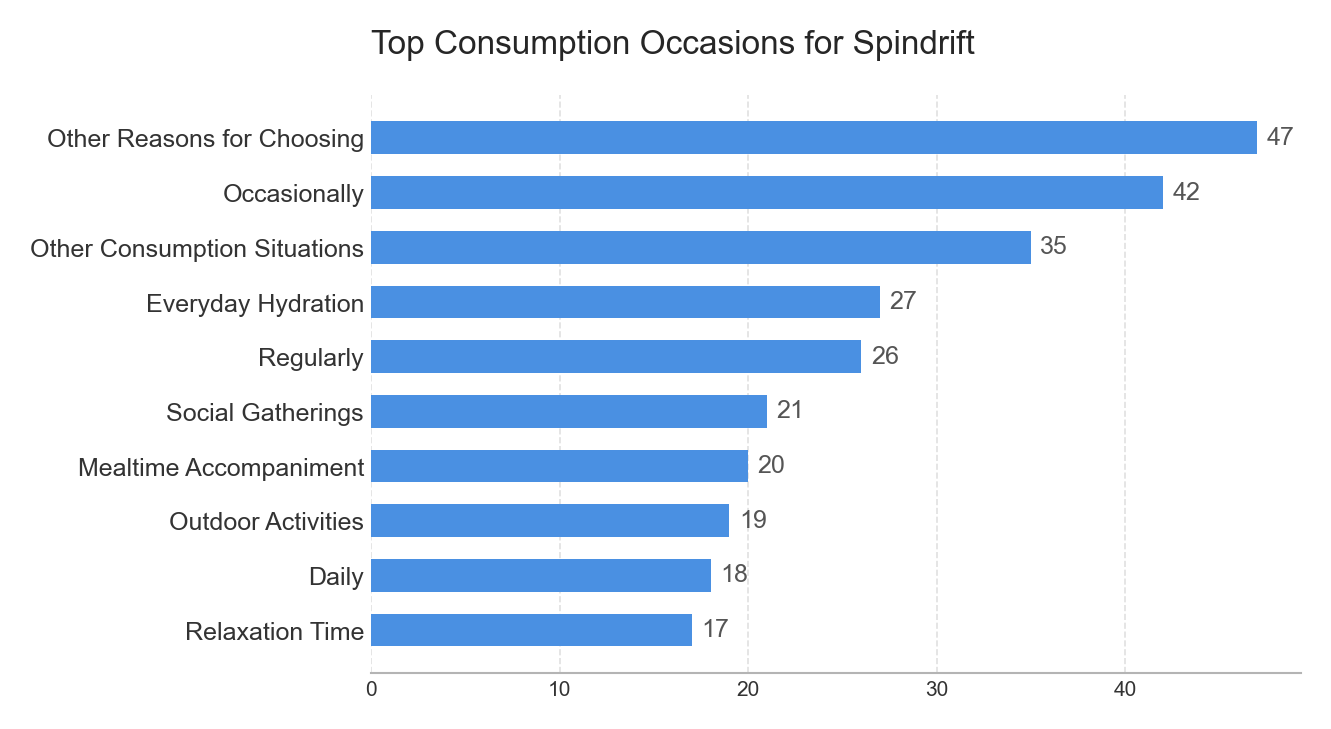
The Spindrift Drinker Persona
Spindrift Drinker Persona: The Conscientious, Balanced Refresher
This persona represents an individual who is discerning about their beverage choices, seeking a harmonious blend of health, taste, and everyday refreshment.
Demographics:
- Age: Primarily spans late twenties to late fifties, with a strong emphasis on the 30-50 age range. While some responses mention "teenagers" or "young people," the core demographic leans towards a more mature consumer.
- Gender: Skews female, frequently described as a "mom" or someone in the "women, late twenties to late fifties" age bracket. However, the appeal is not exclusively limited to women, with mentions of "men and women" and "anybody."
- Socio-economic Status: Predominantly middle to upper-middle class. This consumer has "extra income to afford this type of product over drinking plain water," indicating a capacity and willingness to pay a premium for a preferred beverage.
Lifestyle:
- Balanced & Everyday: This individual leads a generally "laid back and chill" yet often active lifestyle. Spindrift fits seamlessly into various daily routines, from "men and women in the office" to "players on the ball field," or simply as an "everyday kind of person" at home.
- Health-Conscious but Indulgent: They are actively seeking healthier alternatives to traditional sugary sodas and plain water. They view Spindrift as a "clean and refreshing" option, a "little treat sometimes" that aligns with their wellness goals without feeling like a compromise.
- Regular Sparkling Water Consumer: They are likely already buying sparkling water on a regular basis and are open to trying new brands that catch their eye.
Values:
- Natural & Clean Ingredients: A paramount value. The persona prioritizes "more natural ingredients" and beverages that are "clean and refreshing without too much sugar." This directly addresses their desire to avoid artificiality found in many soft drinks.
- Quality & Refinement: There's an appreciation for a "classy" product and an understanding that they are paying for a higher-quality option compared to plain water.
- Taste Experience: While health-conscious, they deeply value taste, specifically enjoying the "carbonation taste" and "milder tastes" that are distinct from overly sweet sodas.
Attitudes:
- Discerning & Deliberate: This consumer makes conscious choices about what they consume, actively avoiding soft drinks and seeking out beverages that support their well-being.
- Open-Minded & Exploratory: They are not rigidly loyal to one brand but are open to trying new products like Spindrift and adding them to their "rotation" if they meet their expectations.
- Relaxed & Appreciative: They embody a "relaxed attitude" and appreciate the simple pleasure of a well-crafted, refreshing drink that offers a subtle yet satisfying flavor profile.
In summary, the typical Spindrift drinker is a health-aware, middle to upper-middle-class individual, often female and aged 30-50, who actively seeks natural, refreshing, and subtly flavorful carbonated beverages as a superior alternative to sugary sodas. They value quality and are willing to invest in products that align with their balanced, discerning lifestyle.
Concluding Synthesis & Strategic Recommendations
The market research clearly delineates Liquid Death and Spindrift as two brands operating at opposite ends of the sparkling water spectrum, each having effectively cultivated a distinct identity and loyal following. Liquid Death has masterfully carved out a fiercely loyal niche by embracing a polarizing, counter-culture identity, resonating deeply with a younger, male-leaning demographic seeking social signaling and an edgy alcohol alternative for high-energy social events.
Strategic Recommendations
For Liquid Death
- 1Deepen Niche Dominance & Cultivate Exclusivity: Instead of attempting to dilute its identity for broader appeal, Liquid Death should double down on its counter-culture roots.
- 2Amplify "Alcohol Alternative" & Extend Occasion Messaging: Systematically partner with venues, bars, and event organizers to position Liquid Death as the premium, non-alcoholic choice for adult social settings.
- 3Strategic Brand Extensions (Carefully Curated): Consider very carefully branded, limited-run line extensions that target adjacent functional needs without compromising the main identity.
For Spindrift
- 1Elevate the "Real Fruit" Narrative & Expand Flavor Innovation: Aggressively market the unique "real squeezed fruit" proposition as a superior taste and health benefit compared to competitors.
- 2Define a Distinctive Lifestyle Integration & Usage Occasions: Move beyond generic "health-conscious" positioning and articulate a clearer, aspirational lifestyle around Spindrift.
- 3Targeted Digital Storytelling & Community Building: Leverage social media platforms popular with millennials and women to tell compelling visual stories about the sourcing of real fruit.